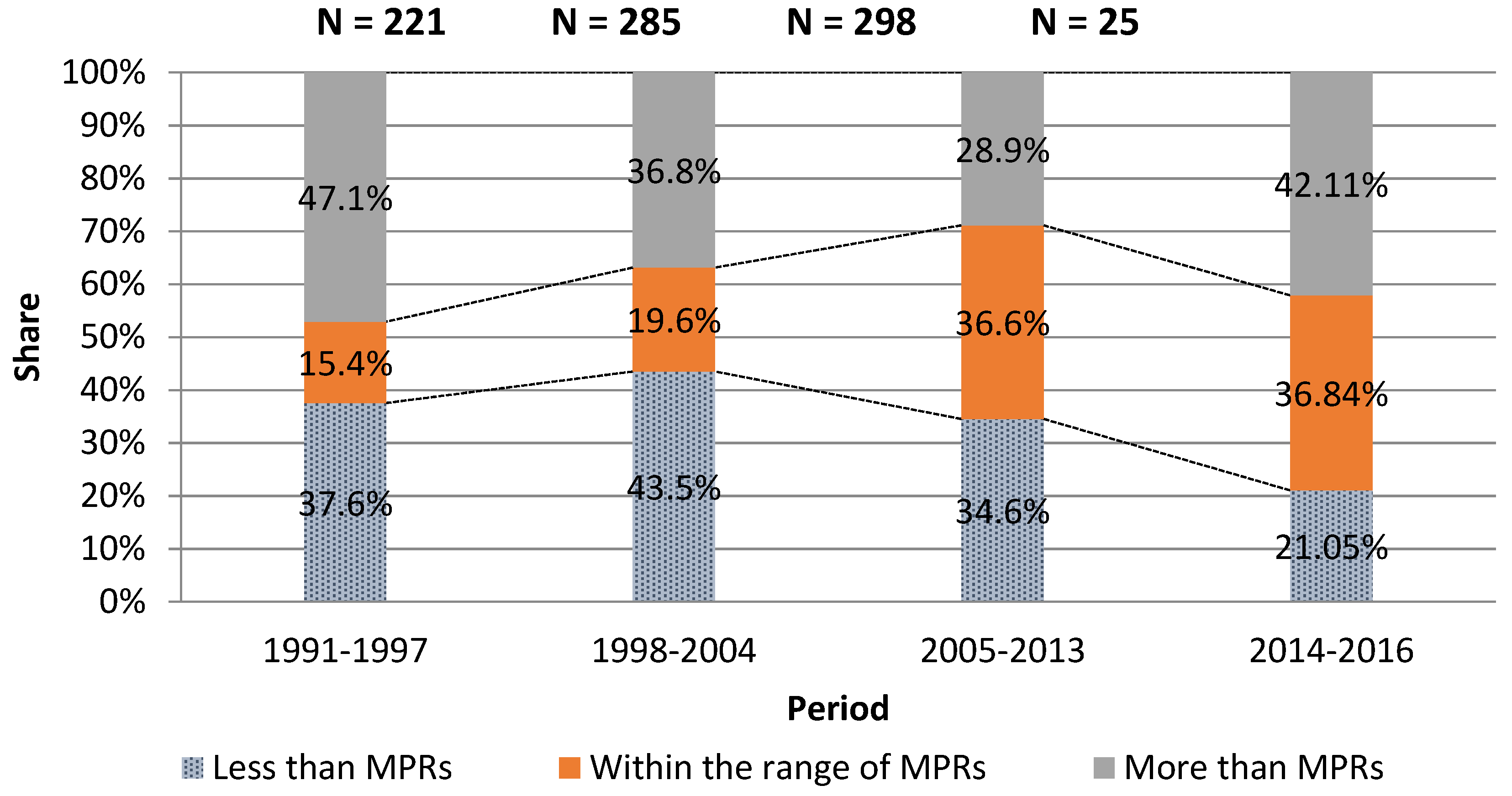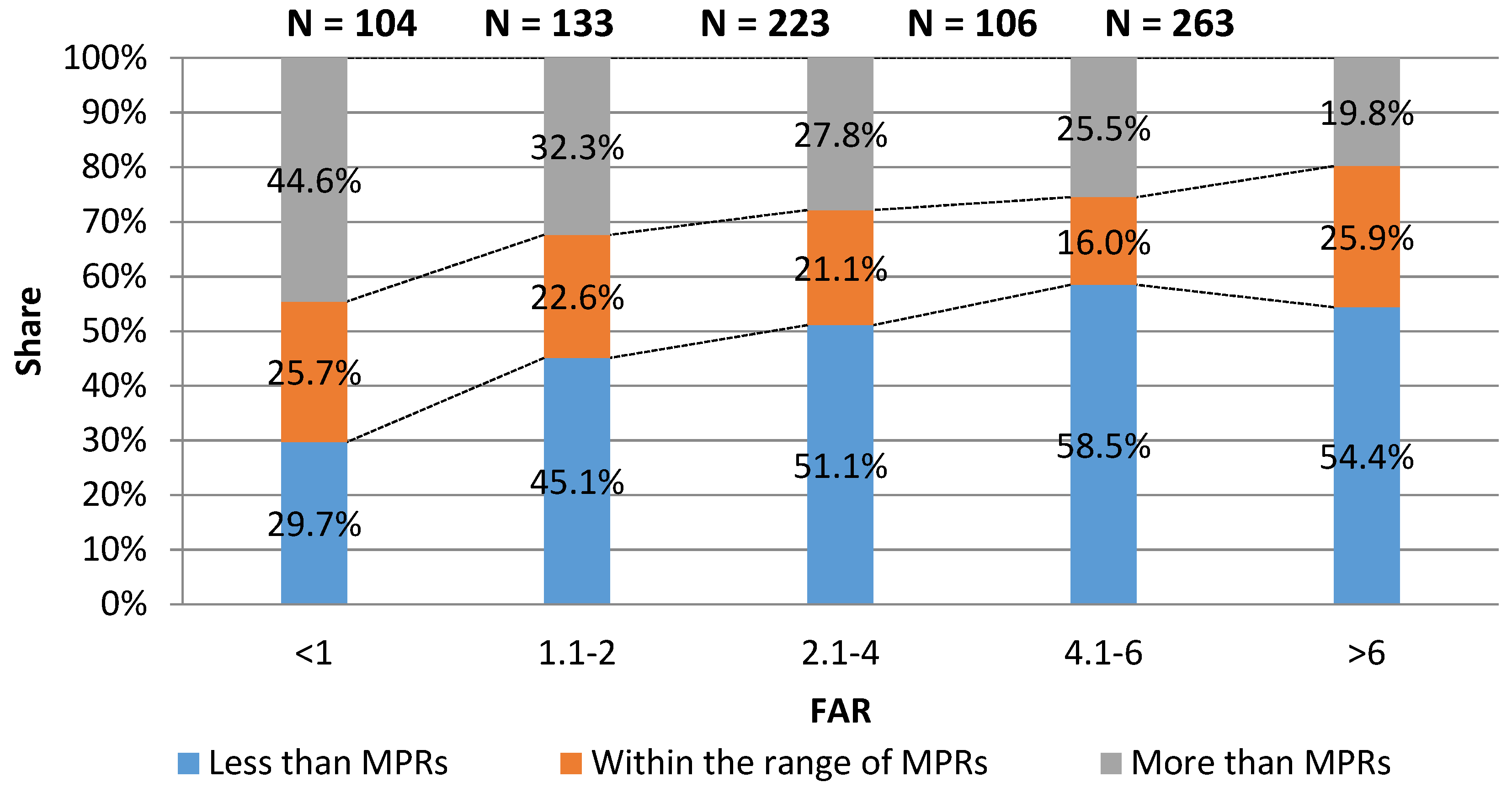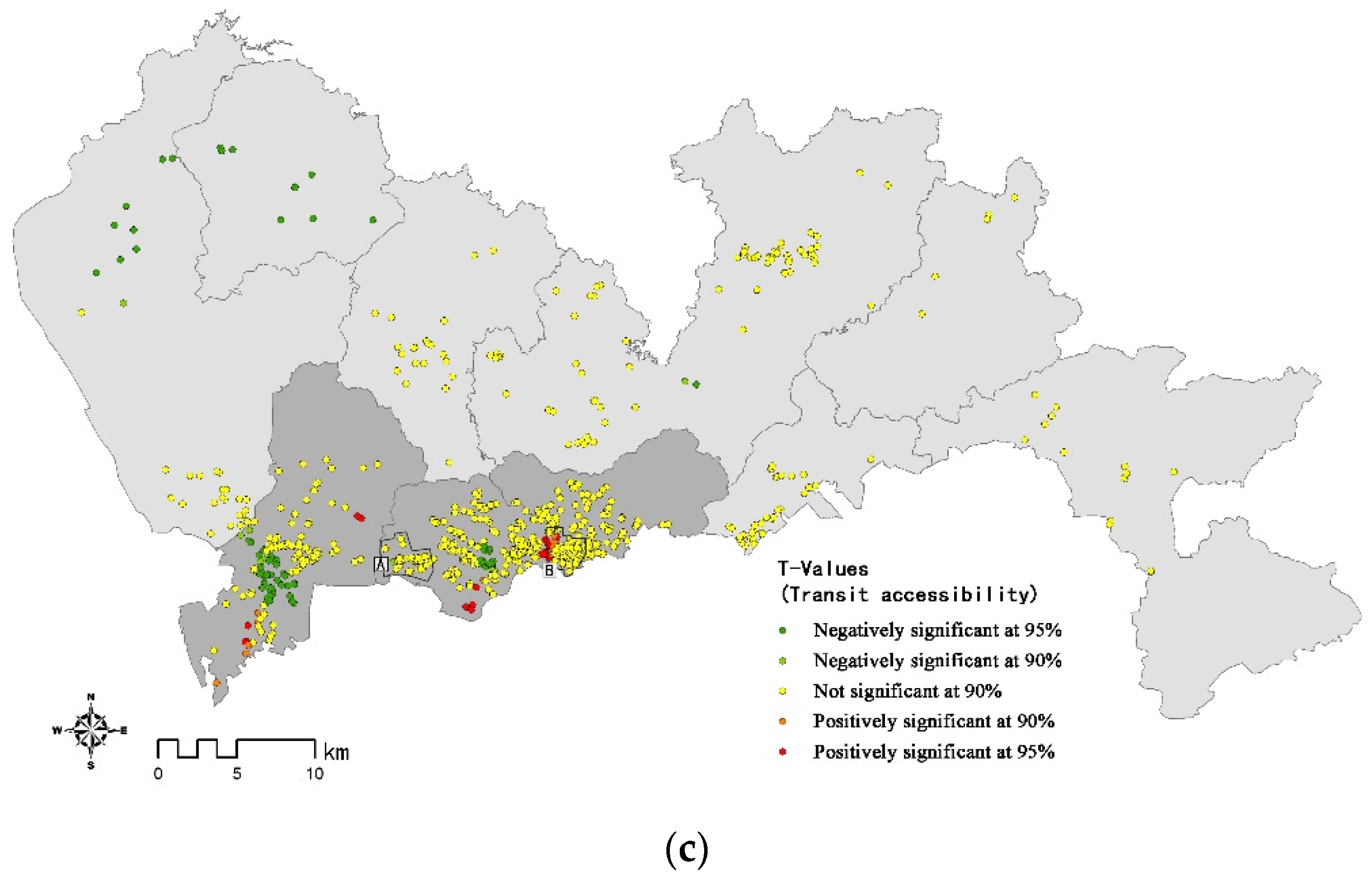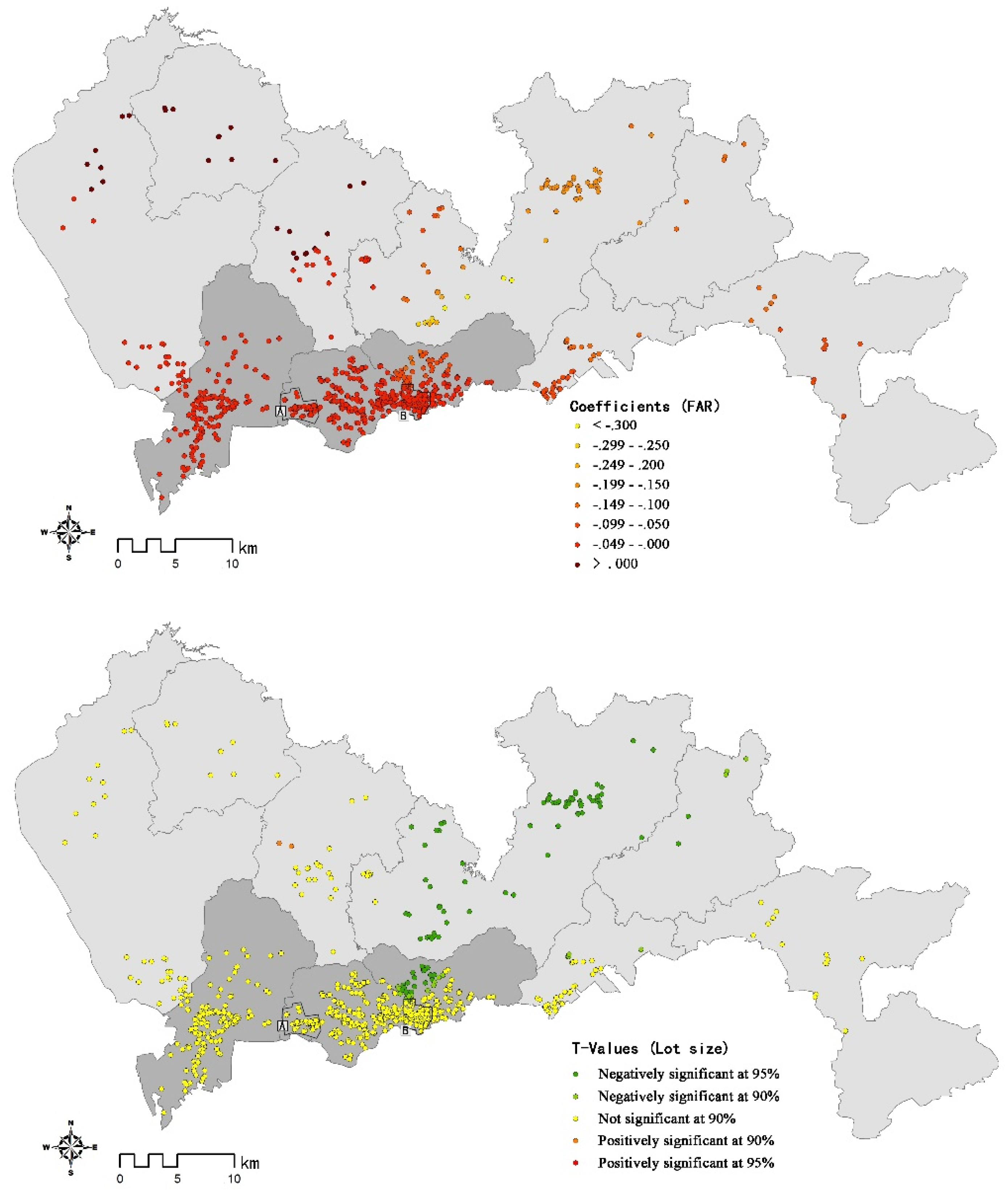Workplace Parking Provision and Built Environments: Improving Context-Specific Parking Standards Towards Sustainable Transport
Abstract
:1. Introduction
2. Literature Review
2.1. The Paradigm Shift in Parking Policy
2.2. Parking Supply and Its Relationships with Built Environments
3. Research Context
3.1. Parking Standards in Shenzhen
3.2. Data and Methodology
4. Effects of Minimum Parking Requirements (MPRs) on Parking Provisions
5. Modeling Analysis
5.1. Ordinary Least Square (OLS) Results
5.2. Geographically Weighted Regression Results
6. Discussion and Conclusions
Author Contributions
Funding
Conflicts of Interest
References
- Johansson, F.; Henriksson, G.; Åkerman, J. Parking Benefit Districts—The transferability of a measure to reduce car dependency to a European context. Transp. Res. Part D Transp. Environ. 2017, 56, 129–140. [Google Scholar] [CrossRef]
- Chu, C.P.; Tsai, M.T. A study of an environmental-friendly parking policy. Transp. Res. Part D Transp. Environ. 2011, 16, 87–91. [Google Scholar] [CrossRef]
- Hensher, D.A.; King, J. Parking demand and responsiveness to supply, pricing and location in the sydney central business district. Transp. Res. Part A 2001, 35, 177–196. Available online: https://raw.githubusercontent.com/gwrtools/gwr4/master/GWR4manual_409.pdf (accessed on 4 April 2018). [CrossRef]
- Su, Q.; Zhou, L. Parking management, financial subsidies to alternatives to drive alone and commute mode choices in Seattle. Reg. Sci. Urban Econ. 2012, 42, 88–97. [Google Scholar] [CrossRef]
- Vaca, E.; Kuzmyak, J.R. Traveler Response to Transportation System Changes. Chapter 13—Parking Pricing and Fees; TCRP Report; TCRP: Washington, DC, USA, 2005. [Google Scholar]
- Guo, Z. Does residential parking supply affect household car ownership? The case of New York City. J. Transp. Geogr. 2013, 26, 18–28. [Google Scholar] [CrossRef]
- Guo, Z. Home parking convenience, household car usage, and implications to residential parking policies. Transp. Policy 2013, 29, 97–106. [Google Scholar] [CrossRef]
- Marsden, G. The evidence base for parking policies—A review. Transp. Policy 2006, 13, 447–457. [Google Scholar] [CrossRef]
- McCahill, C.; Garrick, N. Influence of parking policy on built environment and travel behavior in two New England cities, 1960 to 2007. Transp. Res. Rec. J. Transp. Res. Board 2010, 2187, 123–130. [Google Scholar] [CrossRef]
- Weinberger, R. Death by a thousand curb-cuts: Evidence on the effect of minimum parking requirements on the choice to drive. Transp. Policy 2012, 20, 93–102. [Google Scholar] [CrossRef]
- Wang, J.J.; Liu, Q. Understanding the parking supply mechanism in China: A case study of Shenzhen. J. Transp. Geogr. 2014, 40, 77–88. [Google Scholar] [CrossRef]
- Caicedo, F.; Lopez-Ospina, H.; Pablo-Malagrida, R. Environmental repercussions of parking demand management strategies using a constrained logit model. Transp. Res. Part D Transp. Environ. 2016, 48, 125–140. [Google Scholar] [CrossRef]
- Christiansen, P.; Engebretsen, Ø.; Fearnley, N.; Hanssen, J.U. Parking facilities and the built environment: Impacts on travel behaviour. Transp. Res. Part A Policy Pract. 2017, 95, 198–206. [Google Scholar] [CrossRef]
- Liu, Q.; Wang, J.; Chen, P.; Xiao, Z. How does parking interplay with the built environment and affect automobile commuting in high-density cities? A case study in China. Urban Stud. 2017, 54, 3299–3317. [Google Scholar] [CrossRef]
- Cuddy, M.R. A Practical Method for Developing Context-Sensitive Residential Parking Standards. Ph.D. Dissertation, Rutgers University-Graduate School-New Brunswic, New Brunswick, NJ, USA, 2007. [Google Scholar]
- Kodransky, M.; Hermann, G. Europe’s Parking U-Turn: From Accomodation to Regulation; Institute for Transportation and Development Policy: New York, NY, USA, 2010. [Google Scholar]
- Wang, R.; Yuan, Q. Parking practices and policies under rapid motorization: The case of China. Transp. Policy 2013, 30, 109–116. [Google Scholar] [CrossRef]
- Liu, Q.; Chen, P.; Sun, F. Parking policies in China’s metropolises: Rationales, consequences, and implications. Urban Policy Res. 2018, 36, 186–200. [Google Scholar] [CrossRef]
- Litman, T.; Burwell, D. Issues in sustainable transportation. Int. J. Glob. Environ. Issues 2006, 6, 331–347. [Google Scholar] [CrossRef]
- Shoup, D.C. The trouble with minimum parking requirements. Transp. Res. Part A Policy Pract. 1999, 33, 549–574. [Google Scholar] [CrossRef] [Green Version]
- Shoup, D. The High Cost of Free Parking; American Planning Association: Chicago, IL, USA; Washington, DC, USA, 2005. [Google Scholar]
- Cutter, W.B.; Franco, S.F. Do parking requirements significantly increase the area dedicated to parking? A test of the effect of parking requirements values in Los Angeles County. Transp. Res. Part A Policy Pract. 2012, 46, 901–925. [Google Scholar] [CrossRef] [Green Version]
- Barter, P.A. Off-street parking policy without parking requirements: A need for market fostering and regulation. Transp. Rev. 2010, 30, 571–588. [Google Scholar] [CrossRef]
- Ben-Joseph, E. Book Review: The High Cost of Free Parking. J. Plan. Lit. 2005, 20, 135–136. [Google Scholar] [CrossRef]
- Willson, R.W. Suburban parking requirements: A tacit policy for automobile use and sprawl. J. Am. Plan. Assoc. 1995, 61, 29–42. [Google Scholar] [CrossRef]
- Manville, M.; Shoup, D.C. Parking Requirements as a Barrier to Housing Development: Regulation and Reform in Los Angeles; University of California Transportation Center: Berkeley, CA, USA, 2010. [Google Scholar]
- Engel-Yan, J.; Hollingworth, B.; Anderson, S. Will reducing parking standards lead to reductions in parking supply? Results of extensive commercial parking survey in Toronto, Canada. Transp. Res. Rec. 2007, 2010, 102–110. [Google Scholar] [CrossRef]
- Nelson, A.; Meyer, M.; Ross, C. Parking supply policy and transit use: Case study of Atlanta, Georgia. Transp. Res. Rec. J. Transp. Res. Board 1997, 1604, 60–66. [Google Scholar] [CrossRef]
- McDonnell, S.; Madar, J.; Been, V. Minimum parking requirements and housing affordability in New York City. Hous. Policy Debate 2011, 21, 45–68. [Google Scholar] [CrossRef]
- Guo, Z.; Ren, S. From minimum to maximum: Impact of the London parking reform on residential parking supply from 2004 to 2010? Urban Stud. 2013, 50, 1183–1200. [Google Scholar] [CrossRef]
- Been, V.; Brazill, C.; Madar, J.; McDonnell, S. Searching for the Right Spot: Minimum Parking Requirements and Housing Affordability in New York City; Policy Brief; Furman Center for Real Estate and Urban Policy: New York, NY, USA, 2012. [Google Scholar]
- Li, F.; Guo, Z. Do parking standards matter? Evaluating the London parking reform with a matched-pair approach. Transp. Res. Part A Policy Pract. 2014, 67, 352–365. [Google Scholar] [CrossRef]
- Urban Planning Land and Resources Commission of Shenzhen. Urban Planning Standards and Guideline; Urban Planning Land and Resources Commission of Shenzhen: Shenzhen, China, 1990–2014. [Google Scholar]
- Fotheringham, A.S.; Brunsdon, C.; Charlton, M. Geographically Weighted Regression; John Wiley & Sons, Limited: Chichester, UK, 2003; pp. 159–183. [Google Scholar]
- Nakaya, T. GWR4.09 User Manual: Windows Application for Geographically Weighted Regression Modelling. 2016. [Google Scholar]
- Wang, J.; Zhang, X.; Zhang, H.M. Parking permits management and optimal parking supply considering traffic emission cost. Transp. Res. Part D Transp. Environ. 2018, 60, 92–103. [Google Scholar] [CrossRef]
- Fotheringham, A.S.; Crespo, R.; Yao, J. Geographical and temporal weighted regression (GTWR). Geogr. Anal. 2015, 47, 431–452. [Google Scholar] [CrossRef]
- Huang, B.; Wu, B.; Barry, M. Geographically and temporally weighted regression for modeling spatio-temporal variation in house prices. Int. J. Geogr. Inf. Sci. 2010, 24, 383–401. [Google Scholar] [CrossRef]








| The Changes in Urban Planning Standards and Guidelines of Shenzhen (UPSG) | ||||
| Categories | 1990 UPSG | 1997 UPSG | 2004 UPSG | 2014 UPSG |
| Administration and government offices | 0.7–0.8 | 2.5–3.0 |
|
|
| Financial, joint venture and foreign trade offices | 0.9–1.2 |
|
| |
| General offices | 0.3–0.4 | 0.4–0.6 | ||
| Office Parking Standards in Selective High-Density Cities Worldwide | ||||
| Hong Kong (minimum standards) 1 |
| |||
| Tokyo (minimum standards) | 0.3 | |||
| London (maximum standards) 2,3 |
| |||
| New York City (maximum standards) 4 | Manhattan core: 0.27 1 per 100 m2 or 100 spaces, whichever is less | |||
| Variables | Unit | Average | Min | Max | St. Dev | Specifications |
|---|---|---|---|---|---|---|
| Dependent variables | ||||||
| Total number of parking spaces | Spaces | 148 | 1 | 2581 | 242 | The total number of parking spaces in each building. |
| Parking ratio | Spaces/100 m2 | 0.629 | 0.007 | 8.330 | 1.805 | The actual number of parking spaces per floor area in each building. |
| Independent variables | ||||||
| FAR | m2/m2 | 5.058 | 0.007 | 19.875 | 4.450 | The ratio of the floor area of each building to its site area. |
| Lot size | hectare | 1.167 | 0.031 | 70.069 | 4.067 | The site area of each building. |
| Transit accessibility | - | 270 | 0 | 748 | 190 | A transit accessibility index 1 by grid units. |
| Distance to the city center | km | 7.979 | 0.461 | 49.947 | 9.305 | The distance to the city center by road 2. |
| Job density 2 | 1000 jobs/km2 | 5.733 | 0 | 23.818 | 4.758 | The ratio of the number of office jobs to the area of the traffic analysis zone (TAZ) 3. |
| Operation period | 3.080 | 1 | 5 | 0.884 | The period when the building was completed (1 = before 1990; 2 = from 1991 to 1997; 3 = from 1998 to 2004; 4 = from 2004 to 2013; 5 = after 2014). | |
| Model 1: Absolute Provision | Model 2: Relative Provision | |||||||
|---|---|---|---|---|---|---|---|---|
| Variables | Coefficient | StdError | p-Value | VIF1 | Coefficient | StdError2 | p-Value | VIF |
| Intercept | −15.363 | 35.150 | 0.610 | - | 0.207 | 0.287 | 0.499 | - |
| FAR | 20.843 | 1.870 | 0.000 ***3 | 1.254 | −0.033 | 0.015 | 0.000 *** | 1.254 |
| Lot size | 14.198 | 1.907 | 0.006 ** | 1.066 | 0.045 | 0.016 | 0.424 | 1.066 |
| Transit accessibility | −0.204 | 0.052 | 0.000 *** | 1.751 | −0.000 | 0.000 | 0.106 | 1.751 |
| Distance to the city center | −1.857 | 1.002 | 0.038 * | 1.540 | 0.009 | 0.008 | 0.539 | 1.540 |
| Job density | −1.801 | 1.979 | 0.351 | 1.570 | −0.010 | 0.016 | 0.210 | 1.570 |
| Operation period | 39.759 | 8.670 | 0.000 *** | 1.039 | 0.203 | 0.071 | 0.032 * | 1.039 |
| OLS4 diagnostics | ||||||||
| Number of observations | 829 | 829 | ||||||
| AICc5 | 11276.571 | 3307.101 | ||||||
| Joint F-statistic | 35.954; p = 0.000 | 6.757; p = 0.000 | ||||||
| Joint Wald statistic | 96.936; p = 0.000 | 35.449; p = 0.000 | ||||||
| Koenker (BP) statistic | 45.344; p = 0.000 | 26.539; p = 0.000 | ||||||
| Jarque–Bera statistic | 33,521.086; p = 0.000 | 3,872,834.020; p = 0.000 | ||||||
| R2 | 0.208 | 0.047 | ||||||
| Adjusted R2 | 0.202 | 0.040 | ||||||
| Global Moran’s I summary | ||||||||
| Moran’s Index | 0.048 | 0.001 | ||||||
| Expected Index | −0.001 | −0.001 | ||||||
| Variance | 0.000 | 0.000 | ||||||
| z-score | 4.846 | 0.245 | ||||||
| p-value | 0.000 | 0.807 | ||||||
| Negatively Significant at 95% | Negatively Significant at 90% | Not Significant | Positively Significant at 90% | Positively Significant at 95% | |
|---|---|---|---|---|---|
| Model 3: Absolute provision | |||||
| Lot size | 0.00% | 0.00% | 24.00% | 7.24% | 68.76% |
| FAR | 0.48% | 0.48% | 39.69% | 8.81% | 50.54% |
| Transit accessibility | 10.62% | 3.74% | 79.73% | 1.57% | 4.34% |
| Operation period | 3.38% | 1.81% | 83.72% | 2.90% | 8.20% |
| Job density | 5.79% | 2.90% | 84.44% | 2.77% | 4.10% |
| Model 4: Relative provision | |||||
| FAR | 15.32% | 4.70% | 79.73% | 0.00% | 0.24% |
| Lot size | 0.36% | 1.33% | 85.89% | 2.90% | 9.53% |
| Operation period | 0.24% | 0.00% | 87.33% | 0.84% | 11.58% |
| Transit accessibility | 8.08% | 3.26% | 88.66% | 0.00% | 0.00% |
| Job density | 0.36% | 2.90% | 96.14% | 0.12% | 0.48% |
| Model 3: Absolute Provision | Model 4: Relative Provision | |||||||||||||
|---|---|---|---|---|---|---|---|---|---|---|---|---|---|---|
| Variables | Min. | 1st Qu. | Median | 3rd Qu. | Max. | Positive | Negative | Min. | 1st Qu. | Median | 3rd Qu. | Max. | Positive | Negative |
| Intercept | −1208.892 | −131.722 | −8.179 | 114.669 | 795.324 | 46.80% | 53.20% | −1.611 | 0.396 | 0.622 | 0.752 | 2.443 | 92.76% | 7.24% |
| FAR | −42.375 | 6.738 | 15.292 | 24.793 | 70.582 | 96.38% | 3.62% | −0.383 | −0.041 | −0.024 | −0.020 | 0.073 | 3.14% | 96.86% |
| Lot size | −10.908 | 23.855 | 66.804 | 157.622 | 705.490 | 98.31% | 1.69% | −0.296 | −0.012 | −0.007 | 0.102 | 1.122 | 45.96% | 54.04% |
| Transit accessibility | −1.787 | −0.290 | −0.043 | 0.061 | 1.523 | 37.15% | 62.85% | −0.013 | −0.000 | −0.001 | −0.001 | 0.001 | 21.35% | 78.64% |
| Job density | −66.827 | −7.478 | 0.578 | 8.340 | 120.647 | 54.52% | 45.48% | −0.192 | −0.018 | −0.015 | −0.005 | 0.343 | 11.10% | 88.90% |
| Operation period | −120.101 | −7.847 | 5.042 | 30.850 | 196.302 | 62.61% | 37.39% | −0.707 | −0.010 | 0.027 | 0.152 | 1.585 | 66.95% | 33.05% |
| Diagnostic information | ||||||||||||||
| Degree of freedom (residual: n − 2trace(S) + trace(S’S)) | 579.618 | 748.263 | ||||||||||||
| ML1 based sigma estimate | 132.307 | 1.479 | ||||||||||||
| Unbiased sigma estimate | 158.230 | 1.556 | ||||||||||||
| Log-likelihood | 10,452.135 | 3001.691 | ||||||||||||
| Classic AIC2 | 10,856.061 | 3128.325 | ||||||||||||
| AICc | 10,987.015 | 3138.976 | ||||||||||||
| BIC/MDL3 | 11,809.371 | 3427.196 | ||||||||||||
| CV4 | 80,644.614 | 5.242 | ||||||||||||
| R2 | 0.701 | 0.328 | ||||||||||||
| Adjusted R2 | 0.572 | 0.255 | ||||||||||||
| Moran’s I summary | ||||||||||||||
| Moran’s Index | −0.013 | 0.001 | ||||||||||||
| Expected Index | −0.001 | −0.001 | ||||||||||||
| Variance | 0.000 | 0.000 | ||||||||||||
| z-score | −1.175 | 0.283 | ||||||||||||
| p-value | 0.240 | 0.777 | ||||||||||||
© 2019 by the authors. Licensee MDPI, Basel, Switzerland. This article is an open access article distributed under the terms and conditions of the Creative Commons Attribution (CC BY) license (http://creativecommons.org/licenses/by/4.0/).
Share and Cite
Liu, Q.; Zhu, M.; Xiao, Z. Workplace Parking Provision and Built Environments: Improving Context-Specific Parking Standards Towards Sustainable Transport. Sustainability 2019, 11, 1142. https://doi.org/10.3390/su11041142
Liu Q, Zhu M, Xiao Z. Workplace Parking Provision and Built Environments: Improving Context-Specific Parking Standards Towards Sustainable Transport. Sustainability. 2019; 11(4):1142. https://doi.org/10.3390/su11041142
Chicago/Turabian StyleLiu, Qian, Mingjian Zhu, and Zuopeng Xiao. 2019. "Workplace Parking Provision and Built Environments: Improving Context-Specific Parking Standards Towards Sustainable Transport" Sustainability 11, no. 4: 1142. https://doi.org/10.3390/su11041142




